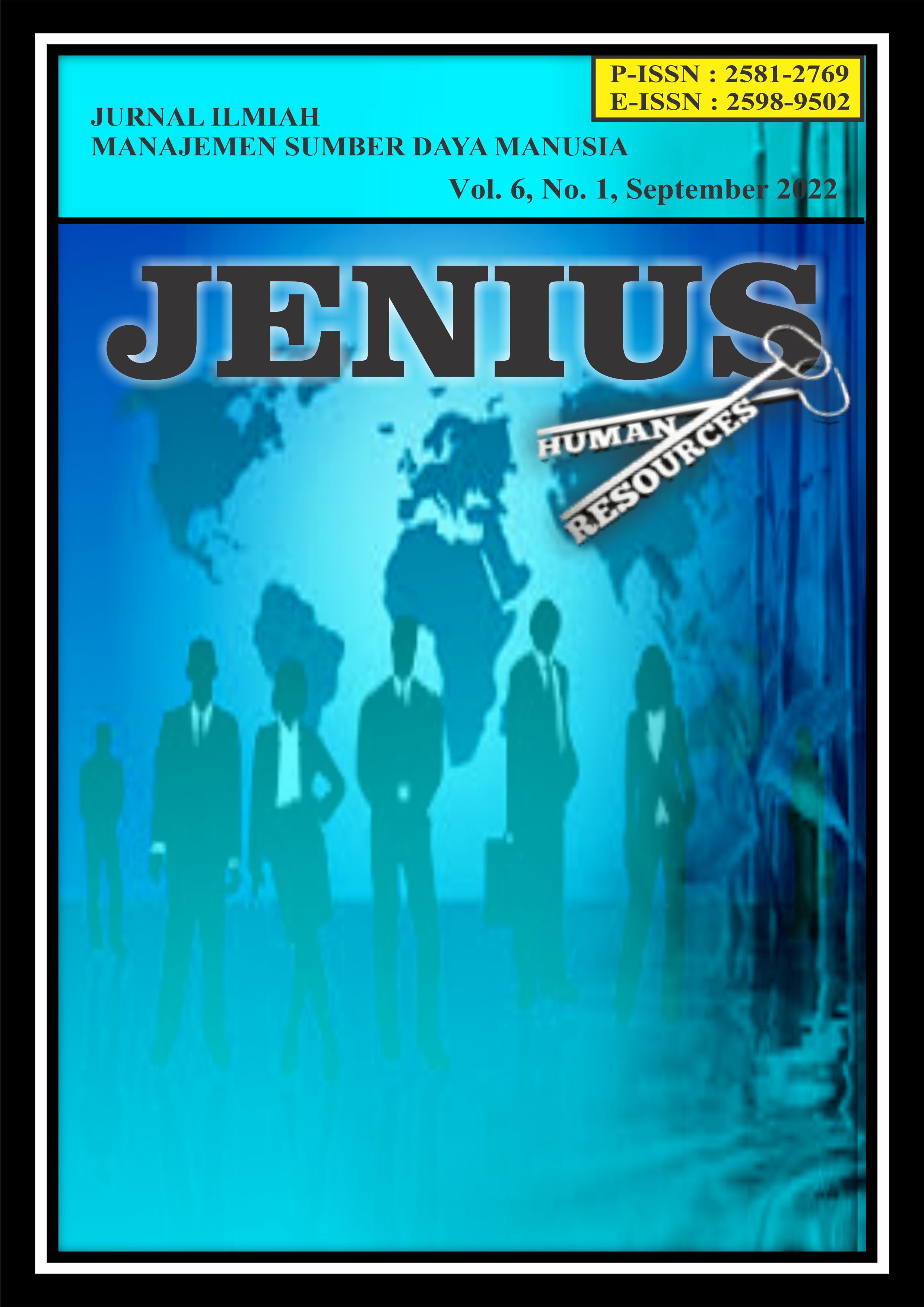The Impact of Working from Home during a Pandemic Against Employee Performance (Exploratory Study)
DOI:
https://doi.org/10.32493/JJSDM.v6i1.20448Keywords:
Work from Home (WFH), Performance, Covid-19 PandemicAbstract
Working from home (WFH) is an efficient solution during the Covid-19 pandemic to maintain productivity and avoid transmission of the coronavirus. However, the pattern of work done from home is different from work done in the office. Of course, the performance produced by employees will be different. Thus, in order to maintain a balance between work and employee commitment, various aspects of WFH are studied. In this study, there were four aspects that were studied during the WFH to see employee performance, namely aspects of space, time, social, and economy. In addition, this study also aims to analyze the advantages and disadvantages of WFH during the Covid-19 pandemic from an employee perspective so that it can be used as evaluation material for the implementation of WFH in the Secretariat of the Language Development and Development Agency. This study used an exploratory method and the data were analyzed descriptively. The survey found six advantages of WFH, namely (1) time flexibility; (2) time efficiency; (3) financial efficiency; (4) energy efficiency; (5) quality time with family; and (6) increased productivity and ten WFH deficiencies, namely (1) lack of facilities; (2) increase in household operational costs; (3) miscommunication; (4) difficulties in supervising the work of employees; (5) difficulty completing work without face to face; (6) difficulty determining priorities; (7) unclear work deadlines; (8) loss of work motivation; (9) the number of distractions at work; and (10) data insecurity.
References
Ainun, Riza, Y., & Suryanto, D. (2021). Analisis Faktor yang Berhubungan terhadap Kinerja Pegawai pada Masa Pandemi Covid-19 di Dinas Kesehatan Kabupaten Tapin Provinsi Kalimantan Selatan Tahun 2021. EPrints UNISKA, 1—10. http://eprints.uniska-bjm.ac.id/7837/
Andriyana, A. S., & Supriansyah. (2021). Konsep Work Life Balance Terhadap Produktivitas Pegawai yang Menerapkan Work From Home Pada Masa Pendemi Covid-19 (Studi Literatur). JENIUS (Jurnal Ilmiah Manajemen Sumber Daya Manusia), 5(1), 1—11. https://doi.org/http://dx.doi.org/10.32493/JJSDM.v5i1.13138
Aristana, I. N., & Dewi, N. K. T. R. (2022). Kinerja di Era 4.0: Apakah Teknologi Informasi dan Knowledge Sharing itu Penting? JENIUS (Jurnal Ilmiah Manajemen Sumber Daya Manusia), 5(2), 250—263. https://doi.org/http://dx.doi.org/10.32493/JJSDM.v5i2.16504
Choukir, J., Alqahtani, M. S., Khalil, E., & Mohamed, E. (2022). Effects of Working from Home on Job Performance: Empirical Evidence in the Saudi Context during the COVID-19 Pandemic. Sustainability, 14(6), 1—18. https://doi.org/https://doi.org/10.3390/su14063216
Crosbie, T., & Moore, J. (2004). No TitleWork–life Balance and Working from Home. Social Policy and Society, 3(3), 223—233. https://doi.org/https://doi.org/10.1017/S1474746404001733
Dharma, P., Windijarto, Ma’ruf, A., & Sucipto, T. H. (2021). Exploration Study Of The Impact Of Working From Home (Wfh) On Employee Performance During The Covid-19 Pandemic. AIRLANGGA DEVELOPMENT JOURNAL, 5(2), 101—110. https://doi.org/https://doi.org/10.20473/adj.v5i2.32050
Felstead, A., Jewson, N., & Walters, S. (2005). The Shifting Locations of Work: New Statistical Evidence on The Spaces and Places of Employment. Work, Employment & Society, 19(2), 415—431. https://www.jstor.org/stable/23748400
Gądecki, J., Jewdokimow, M., & Żadkowska, M. (2018). New Technologies And Family Life In The Context Of Work At Home. The Strategies Of Work‑Life Balance. Studia Humanistyczne AGH, 17(4), 77—89. https://doi.org/http://dx.doi.org/10.7494/human.2018.17.4.77
Garg, A. K., & Rijst, J. van der. (2015). The Benefits and Pitfalls of Employees Working from Home: Study of A Private Company in South Africa. Corporate Board: Role, Duties and Composition, 11(2), 36—49. https://doi.org/10.22495/cbv11i2art3
Golden, T. (2007). Co-Workers Who Telework and The Impact on Those in The Office: Understanding The Implications of Virtual Work for Co-Worker Satisfaction and Turnover Intentions. Human Relations, 60(11), 1641—1667. https://doi.org/https://doi.org/10.1177/0018726707084303
Immanuel, J. (2022). Analisis Faktor-Faktor Work From Home untuk Menilai Kinerja Karyawan Astra Credit Companies Bekasi Pandemi Covid-19. Jurnal Syntax Transformation, 3(1), 90—96. https://doi.org/https://doi.org/10.46799/jst.v3i1.496
Kasmir. (2016). Manajemen Sumber Daya Manusia (Teori dan Praktik). PT Rajagrafindo Persada.
Masrel, O. V. (2020). Bekerja dari Rumah (Work From Home) Dari Sudut Pandang Unit Kepatuhan Internal. Www.Djkn.Kemenkeu.Go.Id. https://www.djkn.kemenkeu.go.id/artikel/baca/13014/Bekerja-dari-Rumah-Work-From-Home-Dari-Sudut-Pandang-Unit-Kepatuhan-Internal.html
Mea, M. H. D., & Hyronimus. (2020). Pengaruh Work From Home Terhadap Work-Life Balance Pekerja Perempuan Di Kota Ende. JMBI UNSRAT (Jurnal Ilmiah Manajemen Bisnis Dan Inovasi Universitas Sam Ratulangi), 7(2), 248—258. https://doi.org/https://doi.org/10.35794/jmbi.v7i2.30266
Mungkasa, O. (2020). Bekerja dari Rumah (Working From Home/WFH): Menuju Tatanan Baru Era Pandemi COVID 19. Jurnal Perencanaan Pembangunan: The Indonesian Journal of Development Planning, 4 (Edisi K(2), 126—150. https://doi.org/https://doi.org/10.36574/jpp.v4i2.119
Nugraheni, J., Pawenang, S., & Mursito, B. (2022). Analisis Kinerja Karyawan di PT Intan Pariwara Klaten. JENIUS (Jurnal Ilmiah Manajemen Sumber Daya Manusia), 5(2), 337—346. https://doi.org/http://dx.doi.org/10.32493/JJSDM.v5i2.16512
KEPUTUSAN MENTERI KESEHATAN REPUBLIK INDONESIA NOMOR HK.01.07/MENKES/382/2020 TENTANG PROTOKOL KESEHATAN BAGI MASYARAKAT DI TEMPAT DAN FASILITAS UMUM DALAM RANGKA PENCEGAHAN DAN PENGENDALIAN CORONA VIRUS DISEASE 2019 (COVID-19), Pub. L. No. NOMOR HK.01.07/MENKES/382/2020 (2020). https://promkes.kemkes.go.id/download/erhj/files4983KMK No. HK.01.07-MENKES-382-2020 ttg Protokol Kesehatan Bagi Masyarakat di Tempat dan Fasilitas Umum Dalam Rangka Pencegahan COVID-19.pdf
Sedayu, A. S., Redina, W. E., Mustaqim, M., Ramadhon, S., & Yono, N. H. (2021). Evaluasi Empat Dimensi Indeks Profesionalitas ASN Kementerian ESDM di Masa Pandemi. Jurnal Administrasi Pendidikan, 28(3), 163—176. https://doi.org/https://doi.org/10.17509/jap.v28i3.39992
Setiawan, N. S., & Fitrianto, A. R. (2021). Pengaruh Work From Home (WFH) terhadap Kinerja Karyawan pada Masa Pandemi COVID-19. Edukatif : Jurnal Ilmu Pendidikan, 3(5), 3229—3242. https://doi.org/https://doi.org/10.31004/edukatif.v3i5.1224
Shirom, A., Gilboa, S. S., Fried, Y., & Cooper, C. L. (2008). Gender, Age and Tenure as Moderators of Work-Related Stressors’ Relationships with Job Performance: A Meta-Analysis. Human Relations, 61(10), 1371—1398. https://doi.org/10.1177/0018726708095708
Soelistyoningrum, J. N. (2020). Pengaruh Efektivitas Work from Home terhadap Loyalitas dan Kinerja Karyawan Kantor Imigrasi Bitung. ESENSI: Jurnal Manajemen Bisnis, 23(3), 321—331. https://ibn.e-journal.id/index.php/ESENSI/article/view/216/192
Tietze, S. (2002). When “Work†Comes “Homeâ€: Coping Strategies of Teleworkers and Their Families. Journal of Business Ethics, 41(4), 385—396. https://www.jstor.org/stable/25074935.
Downloads
Published
How to Cite
Issue
Section
License
Copyright (c) 2022 Sunardi Sunardi

This work is licensed under a Creative Commons Attribution 4.0 International License.
Authors who publish in this journal agree to the following terms:
The author owns the copyright of the article and assigns to the journal the right of first publication with the work simultaneously licensed under the terms Atribusi 4.0 Internasional (CC BY 4.0)
 which allows others to share the work with acknowledgment of the work's authorship and initial publication in this journal.
which allows others to share the work with acknowledgment of the work's authorship and initial publication in this journal.Authors may enter into separate additional contractual arrangements for the non-exclusive distribution of the published journal version of the work (for example, posting it to an institutional repository or publishing it in a book), with acknowledgment of the work's original publication in this journal.
Authors are permitted and encouraged to post their work online (for example, in institutional repositories or on their websites) before and during the submission process, as this can lead to productive exchanges, as well as earlier and larger citations of published work (See The Effect of Open Access).






.png)

